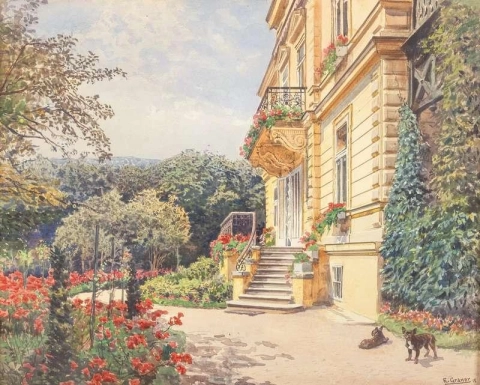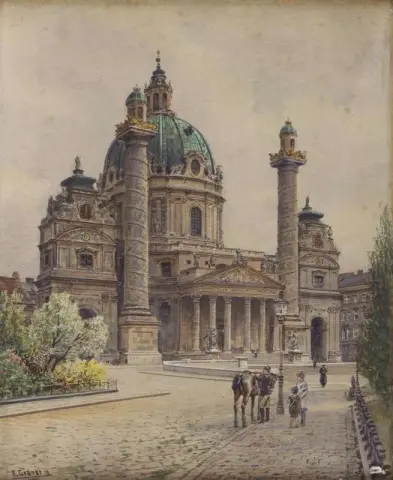

Hand painted reproductions of Ernst Graner
Ernst Graner: A Visionary of 19th-Century German Landscape Art
Ernst Graner (1811–1893) was a renowned German painter, best known for his evocative and meticulously rendered landscapes. His work combines the Romanticism movement’s emotional depth with a profound respect for nature’s beauty and vastness. Graner’s landscapes transport viewers to serene, expansive scenes, using light and color to create a sense of tranquility and contemplation. His legacy endures in the tradition of 19th-century German landscape painting, blending artistic mastery with nature’s quiet grandeur.
Early Life and Education
Ernst Graner was born on June 3, 1811, in the small town of Neudietendorf, Thuringia, Germany. His early interest in art was fostered by his family, and he moved to Dresden to pursue formal artistic training. There, Graner studied at the prestigious Dresden Academy of Fine Arts, where he honed his skills in landscape painting under the guidance of prominent instructors. This period of study allowed Graner to explore both the technical aspects of painting and the expressive qualities of the landscape genre.
Dresden, known for its vibrant artistic community and proximity to the natural beauty of the Saxon Switzerland region, was a formative influence on Graner’s development as a painter. His early exposure to the picturesque and dramatic landscapes of the Elbe River Valley and the surrounding countryside deeply inspired his future works, setting the stage for his lifelong focus on landscape painting.
Artistic Development and Style
Graner’s landscapes were deeply influenced by the Romanticism movement, which emphasized the sublime and the emotional power of nature. Unlike the classical landscapes of earlier periods, Graner’s paintings explored the dynamic relationship between light, shadow, and the ever-changing atmosphere of the natural world. This approach was particularly evident in his depictions of mountainous regions, forests, and rivers, where he captured the majesty and mystery of the landscape in great detail.
Graner often employed a meticulous and naturalistic technique, rendering natural elements with a high degree of precision. However, his works also displayed the emotional depth characteristic of Romanticism. His use of light, especially in the portrayal of sunrise and sunset, imbued his paintings with an almost ethereal quality. He was especially skilled at creating a sense of vastness and depth, often using perspective and atmospheric effects to enhance the viewer’s sense of immersion in the scene.
A hallmark of Graner’s style was his ability to evoke a sense of harmony between humanity and the natural world. His landscapes often featured subtle figures—such as travelers, shepherds, or farmers—integrated into the scene, giving the viewer a sense of scale and connection to the landscape. These figures were painted with the same care and attention to detail as the surrounding nature, reinforcing the theme of human coexistence with nature.
Themes and Significance
Graner’s landscapes were more than simple representations of nature; they were philosophical explorations of the relationship between mankind and the environment. His works reflected the Romantic belief in the transformative power of nature and the idea that the natural world could serve as a mirror for human emotion and spiritual reflection.
His depictions of dramatic mountain ranges, serene rivers, and expansive vistas suggested not just the beauty of the landscape but also its capacity to evoke awe and contemplation. Graner’s attention to light and atmosphere made his works particularly striking, capturing fleeting moments in nature that seem timeless, like the shimmering light of dawn or the golden glow of sunset.
Graner’s work also reflected the German tradition of landscape painting, which placed great importance on the depiction of the natural world as a source of emotional and philosophical significance. His landscapes were often imbued with a sense of grandeur and solitude, reflecting the German notion of the "sublime" in nature—a theme central to the Romantic movement.
Achievements and Recognition
Throughout his career, Ernst Graner received considerable recognition for his contributions to landscape painting. He was well-respected among his peers and exhibited his works in various prestigious venues, including exhibitions in Berlin, Dresden, and Munich. Graner’s landscapes were particularly admired for their technical precision and the emotional atmosphere he was able to evoke through his careful handling of light and color.
His work was highly regarded by critics, and he became a respected member of the German artistic community. Graner was particularly popular among collectors and patrons who valued his ability to capture the grandeur and tranquility of the German countryside. His works were sought after not only for their technical skill but also for their deep emotional resonance.
Today, many of Graner’s works are held in prominent collections across Europe, including the German Historical Museum in Berlin and the Dresden State Art Collections. His landscapes continue to be admired for their beauty, emotional depth, and technical excellence.
Legacy
Ernst Graner’s legacy lies in his significant contributions to the development of 19th-century German landscape painting. He was able to bring together the Romantic tradition of emotional engagement with nature and the technical precision of the landscape genre. His paintings continue to be celebrated for their ability to evoke a sense of connection with the natural world and the sublime.
Graner’s influence can be seen in the work of later German artists, particularly those associated with the Romantic landscape tradition. His focus on light, color, and atmosphere helped to establish a distinctive German school of landscape painting that emphasized the emotional impact of nature. Today, Graner’s works remain a vital part of the German art tradition, celebrated for their evocative power and timeless beauty.
Where to Find Reproductions of Ernst Graner’s Art
For art collectors and admirers of German Romanticism, high-quality reproductions of Ernst Graner’s paintings offer an opportunity to bring the serene beauty of the German countryside into contemporary spaces. These reproductions capture Graner’s exceptional use of light, color, and atmosphere, allowing viewers to experience the tranquility and majesty of nature as portrayed by this master of landscape painting.
Imagine owning an original-style painting by one of the greatest artists in history. At POD, we offer you the chance to make this dream a reality. Each canvas is faithfully reproduced down to the smallest detail, allowing you to experience the beauty of the artist’s vision in your own home.
Our reproductions are crafted by experienced painters using the finest materials and time-honored methods. We are committed to delivering works of exceptional quality that will inspire and bring joy to your family for generations to come.






























